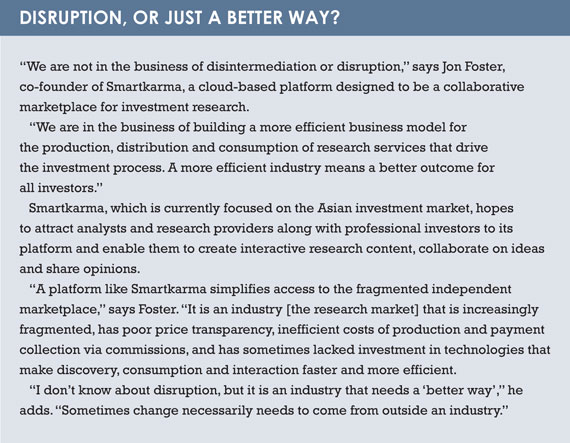In the fintech age, the threatening word ‘disruption’ reverberates around the asset management industry. Yet ‘the barbarians at the gate’ are suddenly welcome, writes Nicholas Pratt.
The funds industry does not enjoy a reputation for technological innovation. But fintech start-ups like Nutmeg and Wealthfront in the retail sector have alerted fund managers to the need to embrace new technologies, whether for distribution or operations.
There is a growing realisation among asset managers and asset servicers such as custodian banks that more can be gained by courting the fintechs.
Prior to last year’s Sibos annual technology conference, Societe Generale Securities Services’ chief digital officer, Damien Jamet, said that fintechs were originally viewed as the barbarians at the gate. But this has changed.
“Fintechs realise they need to become allies of financial institutions, and financial institutions know they need the help of fintechs to integrate advanced technologies into their legacy systems.”
Players in the funds industry are increasingly doing deals with fintechs or importing expertise from the digital world. In January, BNP Paribas Securities Services took a minority stake in a regtech start-up; Schroders contracted a micro-apps developer to help kickstart its digital transformation; and electronic fund reporting firm Kneip appointed a former Skype executive to help drive its own digital push.
There is also a realisation among fund management’s chief executives that services that have proved popular in the retail space will soon be in high demand in the institutional space.
“Institutional investors use mobile apps for their personal finances and they will expect similar experience with their institutional portfolios,” says Fiona Frick, chief executive of Swiss boutique asset manager Unigestion.
The interface between asset managers and their investors will become increasingly important, says Frick. “Robo-advice has provided a fun interface that is easy to use, interactive and educational. It is a premium experience that will be increasingly demanded by institutional investors as they use it in their private life.”
Fintechs will need to add scale as well as sophistication if they are to make any progress in the institutional space and there are signs that regulators are keen to impose more measures on what has been a largely unregulated sector until now.
HERDING BEHAVIOUR
During the G20 conference in January, Bundesbank president Jens Weidmann called for a common criteria for regulating fintechs and warned of the dangers of leaving the fintech sector unchecked.
“Herding behaviour, for example, could be amplified by automated advisory services in portfolio management. Robo-advisers might exacerbate financial volatility and pro-cyclicality if the assets under management reach a significant level,” he said.
Regulators have signalled they are open to innovation as long as it protects end investors and produces better outcomes for them, says Unigestion’s Frick. “And the end investor will have to take more responsibility, become more educated and be much more demanding in terms of their reporting.”
Regulatory reporting and compliance is proving to be one of the more fertile grounds for collaboration between fintechs and financial institutions. In January, BNP Paribas Securities Services (BNPP SS) bought a minority stake in Fortia Financial Solutions, a fintech start-up that uses artificial intelligence, machine learning and business process monitoring for investment fund compliance through its Innova platform.
The deal was conducted through BNPP’s L’Atelier division, an innovation lab that was created 20 years ago and acts as an incubator and accelerator for start-ups.
Jean Devambez, global head of product and clients solutions, asset and fund services at BNP Paribas Securities Services, says: “We looked at the cost to build the minimum viable product and to migrate that to our business. We also looked at the scalability and security of the platform and how it could be applied to a large firm like BNPP SS as opposed to the smaller firms it had worked with previously.
 “And it was an opportunity for us to assess those new technologies, identify the benefits and how they can be used to reinvent investment compliance.”
“And it was an opportunity for us to assess those new technologies, identify the benefits and how they can be used to reinvent investment compliance.”
For example, Innova uses machine learning and natural language processing to load documentation, such as investor information documents, and identify key words that could trigger a compliance rule and then convert that process into a specific calculation formula.
“It is digitising the compliance process and opening the door for digitising other parts of the investment process.”
BNPPSS is working with clients on the use and digitising of structural data, taking portfolio managers’ comments and using natural language generation to run them into standard documents. In addition, it is taking data from aggregation services and other sources to exploit artificial intelligence.
Devambez says that it is important to take a broad approach to new technology. “All of these technologies – blockchain, artificial intelligence, smart data – will really add value when they work with each other and are able to exploit their properties. For example, we are working on proof-of-concepts for fund distribution using blockchain, smart data, artificial intelligence and web scraping.”
The Fortia investment also shows how the fintech market is evolving from a consumer focus to more of a business-to-business approach, which is essential if it is to be widely applied in the asset management market, says Devambez.
DREADED LEGACY
The antithesis to the evolving fintech scene is the dreaded world of legacy systems. For most large asset managers, their main challenge is moving off these inflexible systems and into the digital age – a process termed ‘digital transformation’.
In late January, global asset manager Schroders announced that it had selected Capriza, a developer of mobile micro apps to help with its own digital transformation.
“Everybody in our business has a mobile device and we want to identify those everyday activities that should take one or two minutes, but normally take four or five minutes when logging into a big system,” says Graham Kellen, chief digital officer at Schroders.
“We want to maximise productivity on the go by giving people bite-sized windows into things like approvals so they can do it anywhere. It is about finding those extra moments of productivity to help everybody work more efficiently.”
Many organisations have large enterprise resource planning (ERP) systems that have been in place for many years to manage their business processes and to store data, says Russell Acton, a regional operations head at Capriza. “The problem is that these systems were designed for a different age.
“People are now able to do all of these things on their own personal devices – from buying shares to making payments to ordering an Uber – but when they get to work, it is like stepping back 20 years.”
Capriza builds hundreds of single-function micro-apps it calls ‘zapps’. “It is like pointing a ray-gun at these enterprise systems and breaking them down into several micro-apps. They key is to make these apps as personalised as possible. In theory, an individual can create their own micro-apps,” says Acton.
He expects the platform to be rolled out in a matter of weeks and then it will be an ongoing process of developing new apps. The first phase will focus on the administrative processes – holiday booking forms; invoice queries and so on. The next phase will look at the sales process.
The bigger question is if these same mobile apps can be applied to the trading and investment process where there are far more stringent guidelines. Acton says that the apps essentially sit on top of the existing systems, which have various rules built in, therefore there are no regulatory overheads involved.
“Most platforms aren’t useless but frustratingly inflexible,” says Acton. “This approach puts the user at the centre of the universe and relegates the back-end system to the edges.”
BEST OF INVESTORS
A big question in all this as fintech takes hold in asset management is whether change will go far enough – far enough, that is, for the end investor to gain more value from an industry whose value is often brought into question.
End investors might be better served by a revolution that unseats many incumbents and creates a new and efficient model for the industry, rather than merely making existing models work slightly better. After all, some might argue that putting flashy new apps on the same creaking legacy system is not digital transformation but putting lipstick on a pig.
©2017 funds europe





